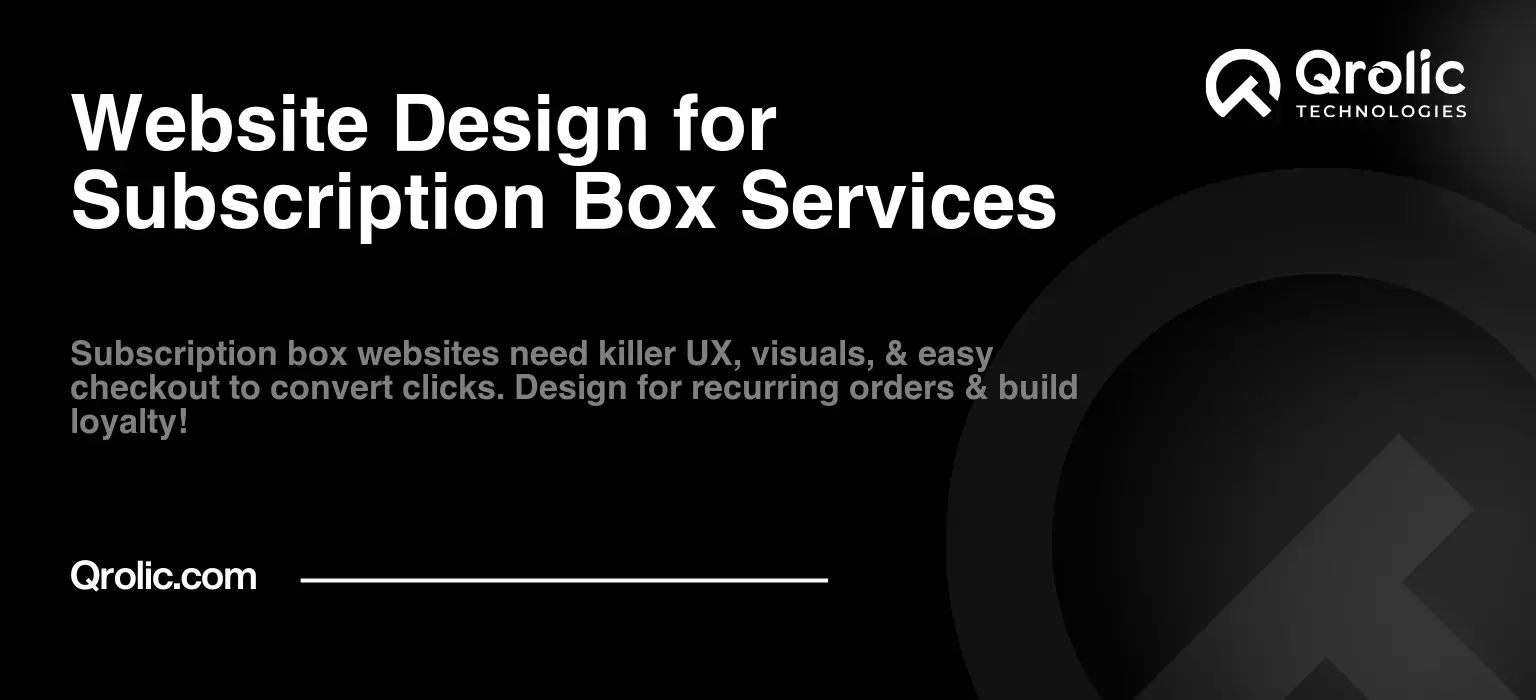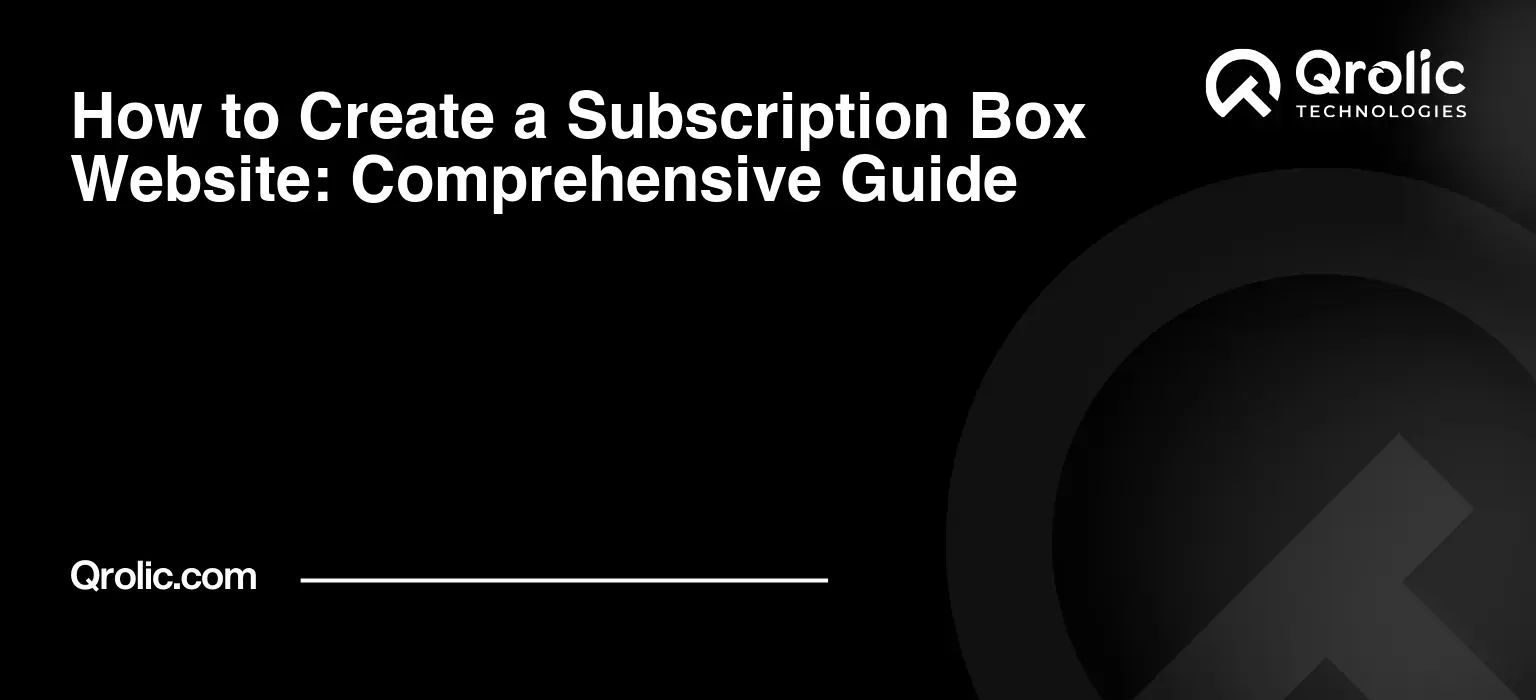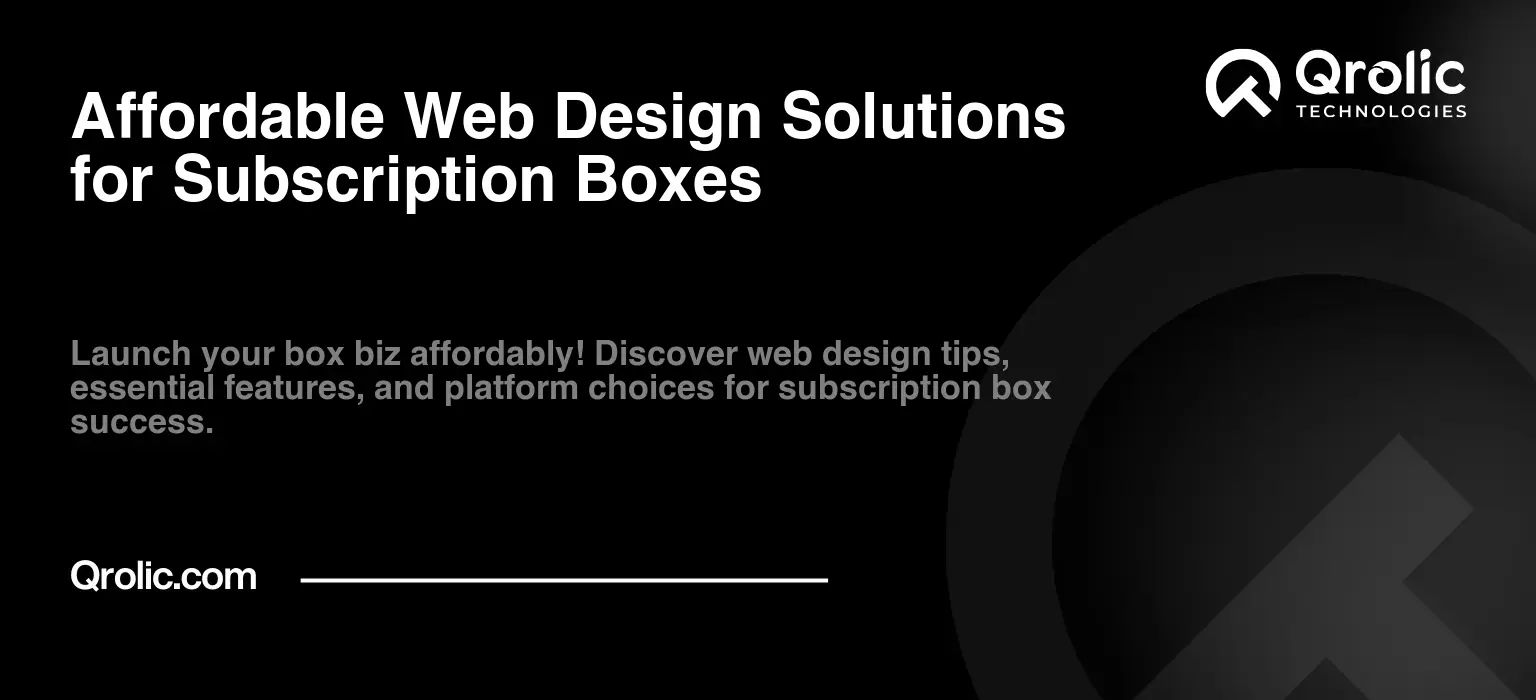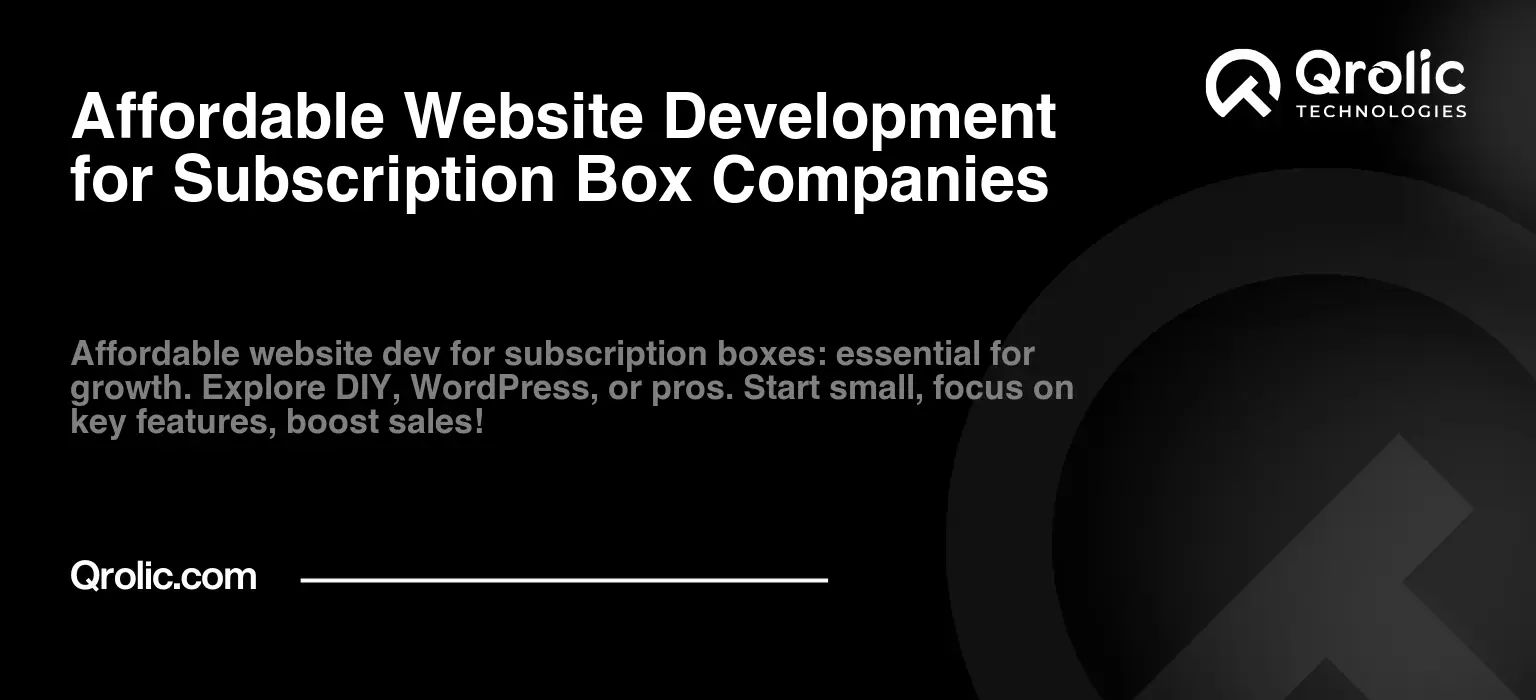The subscription box industry is booming. People love the convenience, the curated experience, and the element of surprise. But having a great product is only half the battle. You need a killer website to turn curious visitors into loyal subscribers and long-term customers. Your website is your digital storefront, your brand ambassador, and your conversion engine. If it’s not up to par, you’re leaving money on the table. This comprehensive guide delves deep into subscription box website design, covering everything from the fundamental principles to advanced optimization techniques. We’ll explore how to create a website that not only looks great but also drives conversions, reduces churn, and builds a thriving subscription business. We’ll also cover best practices for recurring order web development and integrating that smoothly into your overall eCommerce website design.
Quick Summary:
- Prioritize user experience, stunning visuals, and conversions.
- Offer easy subscription management and secure payments.
- Optimize for search engines and plan for future growth.
Table of Contents
- I. The Core Principles of Subscription Box Website Design
- A. User Experience (UX) is King (and Queen)
- B. Visual Appeal: Show, Don’t Just Tell
- C. Conversion Optimization: Turning Browsers into Buyers
- D. Data-Driven Design: Measuring and Refining
- II. Key Website Pages for Subscription Box Services
- A. Homepage: Your Digital First Impression
- B. Subscription Box Pages: The Heart of Your Offering
- C. About Us Page: Telling Your Story
- D. FAQ Page: Addressing Common Questions
- E. Blog: Content Marketing and Engagement
- III. Essential Features for Subscription Box Websites: Functionality That Drives Success
- A. Subscription Management: Empowering Subscribers
- B. Payment Gateway Integration: Secure and Seamless Transactions
- C. Shipping and Fulfillment: Getting Boxes to Subscribers Efficiently
- D. Customer Support: Building Loyalty and Trust
- E. Referral Program: Leveraging Word-of-Mouth Marketing
- IV. Technical Considerations for Subscription Box Websites: Ensuring a Smooth Operation
- A. Choosing the Right Platform: Shopify vs. WooCommerce vs. Custom Development
- B. Hosting: Ensuring Reliability and Performance
- C. Security: Protecting Your Data and Your Customers
- D. Scalability: Planning for Growth
- V. SEO Strategies for Subscription Box Websites: Getting Found Online
- A. Keyword Research: Understanding What Your Audience Searches For
- B. On-Page Optimization: Making Your Website Search Engine Friendly
- C. Off-Page Optimization: Building Authority and Backlinks
- D. Content Marketing: Providing Value and Attracting Customers
- E. Local SEO: Targeting Local Customers (If Applicable)
- VI. Qrolic Technologies: Your Partner in Subscription Box Website Success
- VII. The Future of Subscription Box Website Design: Trends to Watch
- VIII. Conclusion: Building a Thriving Subscription Box Business Starts with a Great Website
I. The Core Principles of Subscription Box Website Design
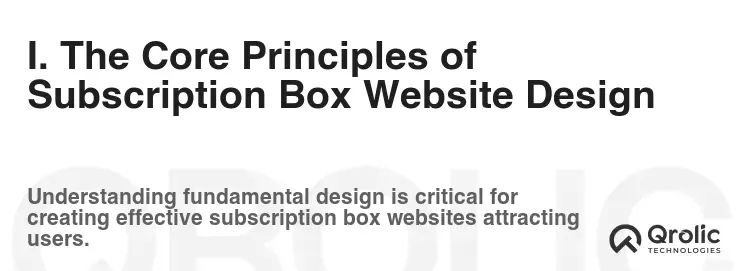
Before diving into the specifics, let’s establish the foundational principles that underpin effective subscription box website design. These principles are the guiding stars that will keep you on track as you build and optimize your online presence.
A. User Experience (UX) is King (and Queen)
- Intuitive Navigation: A confused visitor is a lost visitor. Your website’s navigation must be clear, logical, and easy to use. Imagine your target customer is brand new to the internet; can they still find what they need? Think clear categories (“Shop Boxes,” “About Us,” “FAQ”), a prominent search bar, and a well-structured site map.
- Mobile-First Design: The majority of online traffic comes from mobile devices. Design your website with mobile users in mind, ensuring a responsive layout that adapts seamlessly to different screen sizes. Test your website on various devices to guarantee a smooth mobile experience.
- Fast Loading Speeds: Slow loading times are a conversion killer. Optimize images, leverage browser caching, and choose a reliable hosting provider to ensure your website loads quickly. Every second counts!
- Accessibility: Design your website to be accessible to users with disabilities. Adhere to WCAG guidelines, use alt text for images, and ensure sufficient color contrast. Accessibility not only improves usability but also broadens your reach.
- Clean and Uncluttered Design: Avoid overwhelming visitors with too much information or too many distractions. Use white space strategically, prioritize key elements, and maintain a clean and uncluttered design.
B. Visual Appeal: Show, Don’t Just Tell
- High-Quality Photography and Videography: Invest in professional-quality visuals that showcase your subscription box’s contents and benefits. Use lifestyle imagery to depict the experience of receiving and using your products. Consider short videos that unbox the product.
- Consistent Branding: Maintain a consistent brand identity throughout your website, using your logo, colors, fonts, and imagery to reinforce your brand message. A strong and consistent brand builds trust and recognition.
- Visually Appealing Layout: Create a visually appealing layout that guides the user’s eye and highlights key information. Use a grid-based design, balance visual elements, and create a sense of visual hierarchy.
- Product Showcase: Prominently feature your subscription boxes with clear, engaging descriptions. Use multiple images from different angles, and allow users to zoom in for detail.
- Emotional Connection: Use visuals that evoke emotion and connect with your target audience’s aspirations and values. Show the joy of receiving a thoughtful gift, the excitement of discovering new products, or the satisfaction of pursuing a hobby.
C. Conversion Optimization: Turning Browsers into Buyers
- Clear Call to Actions (CTAs): Guide visitors towards desired actions with clear and compelling CTAs. Use action-oriented language (“Subscribe Now,” “Get Started,” “Explore Boxes”) and make your CTAs visually prominent.
- Simplified Checkout Process: Streamline the checkout process to minimize friction and reduce cart abandonment. Offer multiple payment options, allow guest checkout, and provide clear instructions.
- Trust Signals: Build trust and credibility by displaying security badges, customer testimonials, and social proof. Showcasing positive reviews and customer satisfaction ratings can significantly boost conversions.
- Urgency and Scarcity: Create a sense of urgency and scarcity to encourage immediate action. Use limited-time offers, countdown timers, or highlight the limited availability of certain boxes.
- Personalization: Tailor the user experience to individual preferences and behaviors. Use personalization to recommend relevant products, offer targeted promotions, and create a more engaging experience.
D. Data-Driven Design: Measuring and Refining
- Analytics Tracking: Implement comprehensive analytics tracking to monitor website performance and identify areas for improvement. Use Google Analytics or other analytics tools to track key metrics such as traffic, bounce rate, conversion rate, and customer lifetime value.
- A/B Testing: Conduct A/B testing to compare different design variations and optimize elements such as headlines, CTAs, and landing pages. Test different options to see what resonates best with your audience.
- Heatmaps and User Recordings: Use heatmaps and user recordings to understand how users interact with your website. Identify areas where users are getting stuck or dropping off, and use this information to improve usability.
- Customer Feedback: Gather customer feedback through surveys, polls, and reviews. Listen to what your customers are saying and use their feedback to inform your design decisions.
- Iterative Improvement: Continuously monitor, analyze, and refine your website design based on data and feedback. Website design is an ongoing process, not a one-time event.
II. Key Website Pages for Subscription Box Services
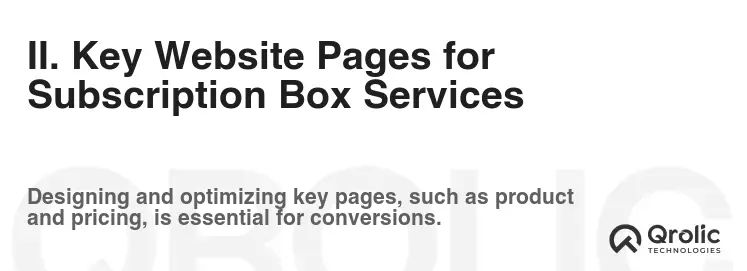
Now that we’ve covered the core principles, let’s examine the key pages that are essential for any subscription box website.
A. Homepage: Your Digital First Impression
The homepage is your opportunity to make a strong first impression and capture visitors’ attention. It should immediately communicate your value proposition, showcase your brand, and guide visitors towards desired actions.
- Compelling Headline: Craft a headline that clearly and concisely communicates the value proposition of your subscription box. Focus on the benefits, not just the features.
- Hero Image or Video: Use a high-quality hero image or video to visually showcase your subscription box and its contents. Depict the experience of receiving and using your products.
- Brief Description: Provide a brief, engaging description of your subscription box, highlighting its key features and benefits. Target your ideal customer’s pain points.
- Featured Boxes: Showcase your most popular or newest subscription boxes with clear product descriptions and enticing visuals.
- Call to Action: Include a prominent call to action that encourages visitors to explore your boxes or subscribe.
- Social Proof: Display social proof such as customer testimonials, reviews, or social media mentions.
- Navigation Menu: Ensure a clear and intuitive navigation menu that allows visitors to easily find what they’re looking for.
B. Subscription Box Pages: The Heart of Your Offering
The subscription box pages are where you showcase the details of your different box options and convince visitors to subscribe.
- High-Quality Images: Use high-quality images from multiple angles to showcase the contents of each box. Allow users to zoom in for detail.
- Detailed Descriptions: Provide detailed descriptions of the box’s contents, highlighting the value and benefits of each item. Be specific and avoid vague language.
- Target Audience: Clearly identify the target audience for each box (e.g., “For coffee lovers,” “For skincare enthusiasts”).
- Pricing and Plans: Clearly display the pricing and subscription plans, including monthly, quarterly, and annual options. Make it easy to understand the different pricing tiers and their benefits.
- Subscription Options: Offer flexible subscription options, such as the ability to skip a month, cancel anytime, or customize the contents of the box.
- Customer Reviews: Display customer reviews and ratings for each box to build trust and credibility.
- Call to Action: Include a prominent call to action that encourages visitors to subscribe to the box.
C. About Us Page: Telling Your Story
The About Us page is your opportunity to connect with visitors on a personal level and share your brand’s story.
- Brand Story: Tell the story of your brand, including your mission, values, and the inspiration behind your subscription box.
- Team Introduction: Introduce your team and share your expertise and passion for your products.
- Behind-the-Scenes: Share behind-the-scenes photos or videos of your operations to give visitors a glimpse into your company culture.
- Social Impact: Highlight any social or environmental initiatives that your company supports.
- Contact Information: Provide clear and easy-to-find contact information, including your email address, phone number, and physical address.
- Call to Action: Encourage visitors to connect with you on social media or subscribe to your email list.
D. FAQ Page: Addressing Common Questions
The FAQ page is a valuable resource for addressing common questions and concerns, reducing customer support inquiries, and building trust.
- Comprehensive List: Create a comprehensive list of frequently asked questions about your subscription box, including shipping, billing, cancellation, and returns.
- Clear and Concise Answers: Provide clear and concise answers to each question, using simple language and avoiding jargon.
- Categorization: Categorize the questions by topic to make it easier for visitors to find the information they’re looking for.
- Search Functionality: Include a search functionality that allows visitors to quickly find answers to their specific questions.
- Contact Information: Provide contact information for additional support if visitors can’t find the answers they need.
- Proactive Approach: Anticipate potential questions and address them proactively on the FAQ page.
E. Blog: Content Marketing and Engagement
A blog is a powerful tool for content marketing, SEO, and customer engagement.
- Valuable Content: Create valuable content that is relevant to your target audience and addresses their interests and needs.
- Keyword Research: Conduct keyword research to identify topics that your target audience is searching for.
- Consistent Posting: Maintain a consistent posting schedule to keep your blog fresh and engaging.
- Engaging Format: Use a variety of content formats, such as articles, videos, infographics, and podcasts.
- Call to Action: Include a call to action at the end of each blog post that encourages visitors to subscribe to your email list or explore your subscription boxes.
- SEO Optimization: Optimize your blog posts for search engines by using relevant keywords, meta descriptions, and image alt text.
III. Essential Features for Subscription Box Websites: Functionality That Drives Success
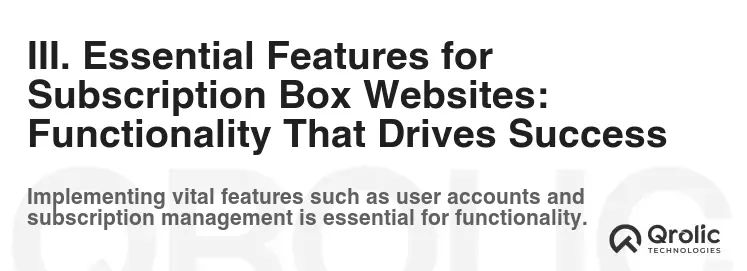
Beyond the core pages, certain features are crucial for the functionality and success of your subscription box website design. These features streamline the subscription process, enhance the user experience, and ultimately boost conversions.
A. Subscription Management: Empowering Subscribers
- Account Creation and Management: Allow subscribers to easily create and manage their accounts, including updating their billing information, shipping address, and subscription preferences.
- Subscription Options: Offer flexible subscription options, such as the ability to skip a month, cancel anytime, or pause their subscription.
- Customization Options: If possible, allow subscribers to customize the contents of their box based on their preferences.
- Renewal Reminders: Send automated renewal reminders to subscribers before their subscription is renewed.
- Cancellation Process: Make the cancellation process easy and transparent, avoiding any hidden fees or confusing procedures.
B. Payment Gateway Integration: Secure and Seamless Transactions
- Secure Payment Processing: Integrate with a secure payment gateway that protects subscribers’ financial information.
- Multiple Payment Options: Offer multiple payment options, such as credit cards, debit cards, PayPal, and other popular payment methods.
- Recurring Billing: Implement recurring billing functionality to automatically charge subscribers on a regular basis.
- PCI Compliance: Ensure that your payment gateway and website are PCI compliant to protect sensitive data.
C. Shipping and Fulfillment: Getting Boxes to Subscribers Efficiently
- Shipping Calculation: Integrate with shipping providers to automatically calculate shipping costs based on the subscriber’s location and the weight of the box.
- Order Tracking: Provide subscribers with order tracking information so they can monitor the status of their shipments.
- Fulfillment Integration: Integrate with a fulfillment provider to streamline the shipping and fulfillment process.
- Address Verification: Implement address verification to ensure that shipments are delivered to the correct address.
D. Customer Support: Building Loyalty and Trust
- Live Chat: Offer live chat support to provide instant assistance to subscribers with questions or issues.
- Contact Form: Provide a contact form for subscribers to submit inquiries or feedback.
- Email Support: Respond to email inquiries promptly and professionally.
- Phone Support: Offer phone support for subscribers who prefer to speak to a customer service representative.
- Knowledge Base: Create a knowledge base with articles and tutorials that address common questions and issues.
E. Referral Program: Leveraging Word-of-Mouth Marketing
- Incentivized Referrals: Offer incentives to subscribers who refer new customers, such as discounts, free boxes, or other rewards.
- Easy Sharing: Make it easy for subscribers to share their referral links on social media and through email.
- Tracking and Reporting: Track referral activity and provide reports on the performance of the referral program.
IV. Technical Considerations for Subscription Box Websites: Ensuring a Smooth Operation
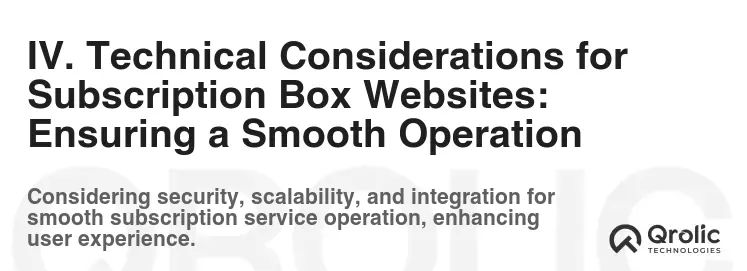
Beyond design and functionality, the technical aspects of your website are crucial for ensuring a smooth and efficient operation. Careful planning and execution of these technical considerations will contribute to a better user experience and long-term success.
A. Choosing the Right Platform: Shopify vs. WooCommerce vs. Custom Development
Selecting the right platform is a fundamental decision that will impact your website’s functionality, scalability, and maintenance. Here’s a breakdown of the most popular options:
- Shopify: A popular eCommerce platform that offers a user-friendly interface, a wide range of apps, and robust subscription functionality. It’s a good choice for businesses that want a simple and straightforward solution with minimal technical overhead.
- Pros: Easy to use, hosted solution, wide range of apps, good subscription support.
- Cons: Can be expensive, limited customization options compared to other platforms.
- WooCommerce: A wordpress plugin that transforms your website into an eCommerce store. It offers more flexibility and customization options than Shopify but requires more technical expertise.
- Pros: Highly customizable, open-source, large community, wide range of plugins.
- Cons: Requires more technical expertise, can be more complex to manage, security is your responsibility.
- Custom Development: Building a custom website from scratch offers the most flexibility and control but is also the most expensive and time-consuming option. It’s a good choice for businesses with unique requirements that cannot be met by existing platforms.
- Pros: Fully customizable, tailored to your specific needs, complete control over the code.
- Cons: Most expensive option, requires significant technical expertise, longer development time.
Consider factors like your budget, technical skills, and specific requirements when choosing a platform. For recurring order Web Development, make sure the platform you select integrates seamlessly with subscription management tools and payment gateways.
B. Hosting: Ensuring Reliability and Performance
Choosing a reliable hosting provider is essential for ensuring your website’s uptime and performance. Consider factors such as server location, bandwidth, storage, and security features.
- Shared Hosting: The cheapest option, but can be slow and unreliable.
- VPS Hosting: Offers more resources and control than shared hosting, but requires more technical expertise.
- Dedicated Hosting: Provides the highest level of performance and control, but is also the most expensive option.
- Cloud Hosting: A scalable and flexible option that allows you to pay for only the resources you need.
Choose a hosting provider that offers excellent customer support and a solid uptime guarantee.
C. Security: Protecting Your Data and Your Customers
Website security is paramount for protecting your data and your customers’ financial information. Implement the following security measures:
- SSL Certificate: Install an SSL certificate to encrypt data transmitted between your website and your users.
- Strong Passwords: Use strong passwords for all your accounts and encourage your users to do the same.
- Regular Backups: Back up your website regularly to protect against data loss.
- Security Plugins: Use security plugins to protect your website from malware, hacking attempts, and other threats.
- PCI Compliance: Ensure that your website and payment gateway are PCI compliant to protect sensitive data.
D. Scalability: Planning for Growth
As your subscription box business grows, your website needs to be able to handle increased traffic and transactions. Choose a platform and hosting provider that can scale to meet your growing needs.
- Scalable Architecture: Design your website with a scalable architecture that can easily accommodate increased traffic and data.
- Content Delivery Network (CDN): Use a CDN to distribute your website’s content across multiple servers, improving performance and reducing latency.
- Database Optimization: Optimize your database to improve performance and scalability.
- Load Balancing: Implement load balancing to distribute traffic across multiple servers, preventing overload.
V. SEO Strategies for Subscription Box Websites: Getting Found Online
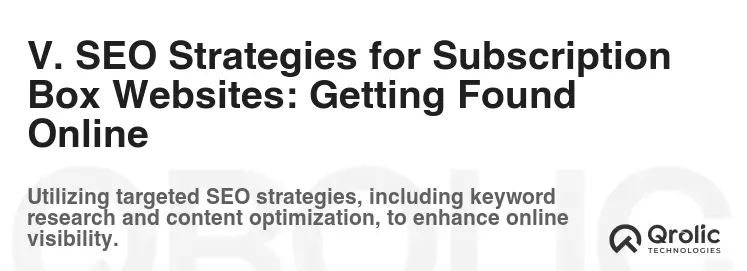
Having a beautiful and functional website is only useful if people can find it. Implementing effective SEO strategies is crucial for driving organic traffic and attracting potential subscribers.
A. Keyword Research: Understanding What Your Audience Searches For
- Identify Target Keywords: Identify the keywords that your target audience is using to search for subscription boxes and related products.
- Use Keyword Research Tools: Use keyword research tools like Google Keyword Planner, Ahrefs, or SEMrush to find relevant keywords with high search volume and low competition.
- Long-Tail Keywords: Focus on long-tail keywords, which are longer and more specific phrases that target a niche audience.
- Competitor Analysis: Analyze your competitors’ websites to see what keywords they are targeting.
B. On-Page Optimization: Making Your Website Search Engine Friendly
- Title Tags: Optimize your title tags with relevant keywords to improve your website’s ranking in search results.
- Meta Descriptions: Write compelling meta descriptions that entice users to click on your website in search results.
- Header Tags: Use header tags (H1, H2, H3, etc.) to structure your content and highlight important keywords.
- Content Optimization: Optimize your website’s content with relevant keywords, ensuring that it is informative, engaging, and valuable to your target audience.
- Image Alt Text: Use descriptive alt text for your images to improve accessibility and help search engines understand the content of your images.
- Internal Linking: Use internal linking to connect different pages on your website, improving navigation and helping search engines understand your website’s structure.
C. Off-Page Optimization: Building Authority and Backlinks
- Link Building: Build high-quality backlinks from other websites to improve your website’s authority and ranking in search results.
- Social Media Marketing: Promote your website and content on social media to increase brand awareness and drive traffic.
- Guest Blogging: Write guest posts for other websites in your niche to reach a wider audience and build backlinks.
- Online Directories: List your website in relevant online directories to increase visibility.
- Public Relations: Generate press coverage for your subscription box to increase brand awareness and build backlinks.
D. Content Marketing: Providing Value and Attracting Customers
- Blog Posts: Create informative and engaging blog posts that address your target audience’s interests and needs.
- Videos: Create videos that showcase your subscription boxes and provide valuable information.
- Infographics: Create visually appealing infographics that present complex information in an easy-to-understand format.
- Ebooks: Create ebooks that provide in-depth information on topics related to your subscription boxes.
- Case Studies: Create case studies that showcase the benefits of your subscription boxes and demonstrate their value.
E. Local SEO: Targeting Local Customers (If Applicable)
- Google My Business: Claim and optimize your Google My Business listing to improve your visibility in local search results.
- Local Citations: List your business in relevant local directories and online review sites.
- Local Keywords: Target local keywords in your website’s content and meta descriptions.
- Reviews: Encourage customers to leave reviews on Google, Yelp, and other online review sites.
VI. Qrolic Technologies: Your Partner in Subscription Box Website Success

At Qrolic Technologies (https://qrolic.com/), we understand the unique challenges and opportunities of the subscription box industry. We are a full-service web development company with extensive experience in eCommerce website design, recurring order web development, and subscription box website design.
We offer a comprehensive suite of services to help you create a website that not only looks great but also drives conversions, reduces churn, and builds a thriving subscription business. Our services include:
- Website Design and Development: We create custom website designs that are tailored to your brand and target audience.
- ECommerce Development: We build robust and scalable eCommerce platforms that can handle high volumes of traffic and transactions.
- Subscription Management Integration: We integrate your website with subscription management platforms to automate billing, shipping, and customer support.
- Payment Gateway Integration: We integrate your website with secure payment gateways to ensure seamless and secure transactions.
- SEO Optimization: We optimize your website for search engines to drive organic traffic and attract potential subscribers.
- Content Marketing: We create engaging content that attracts and retains customers.
- Ongoing Support and Maintenance: We provide ongoing support and maintenance to ensure that your website is always up-to-date and performing optimally.
We are committed to providing our clients with the highest level of service and support. We work closely with you to understand your business goals and develop a website that meets your specific needs. Contact us today to learn more about how we can help you create a successful subscription box website.
VII. The Future of Subscription Box Website Design: Trends to Watch

The subscription box industry is constantly evolving, and website design trends are changing along with it. Here are some trends to watch in the future:
- Personalization: Consumers are increasingly demanding personalized experiences. Expect to see more subscription box websites offering customized product recommendations, tailored content, and personalized offers.
- Artificial Intelligence (AI): AI is being used to enhance the user experience on subscription box websites, from chatbots that provide instant customer support to AI-powered product recommendations.
- Augmented Reality (AR): AR is being used to allow customers to virtually “try on” products before subscribing, enhancing the shopping experience and reducing returns.
- Sustainability: Consumers are increasingly concerned about sustainability. Expect to see more subscription box websites emphasizing eco-friendly packaging, sustainable products, and ethical sourcing.
- Community Building: Subscription boxes are increasingly becoming about more than just the products; they’re about building a community. Expect to see more subscription box websites incorporating community features, such as forums, social media groups, and events.
- Interactive Content: From quizzes to product configurators, interactive content that engages users and provides them value will become even more popular.
By staying on top of these trends, you can ensure that your subscription box website remains cutting-edge and continues to attract and retain customers.
VIII. Conclusion: Building a Thriving Subscription Box Business Starts with a Great Website
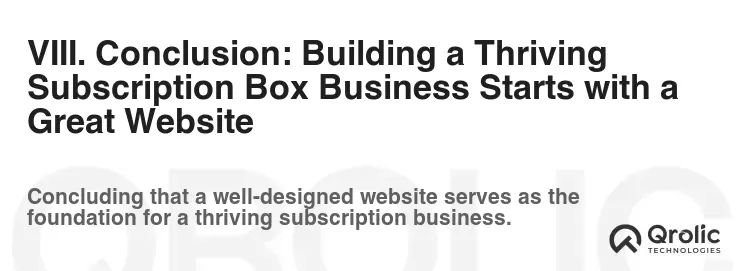
Your subscription box website design is the cornerstone of your business. By focusing on user experience, visual appeal, conversion optimization, and technical considerations, you can create a website that attracts customers, drives subscriptions, and builds a thriving business. Remember to prioritize recurring order Web Development to offer seamless management of subscriptions. A robust, user-friendly eCommerce website design combined with effective SEO strategies will propel your subscription box business to new heights. It’s a continuous process of refinement and improvement, adapting to the ever-changing landscape of eCommerce and consumer expectations. Invest in your website, and it will invest in you, delivering long-term success and a loyal customer base.
